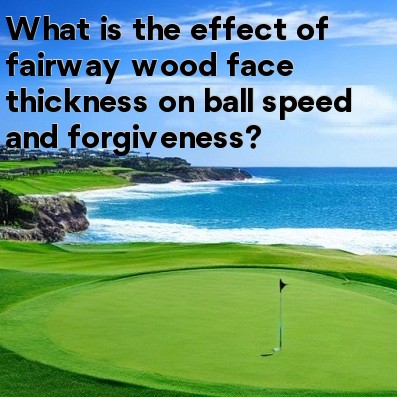
In golf, the effect of fairway wood face thickness on ball speed and forgiveness
When it comes to fairway woods in golf, the thickness of the clubface can have a significant impact on both ball speed and forgiveness. The clubface is the part of the club that strikes the golf ball, and its design plays a crucial role in how effectively energy is transferred from the club to the ball.
Ball speed is a critical factor in determining how far the golf ball will travel. A thicker clubface tends to create a larger sweet spot, resulting in more forgiveness and higher ball speeds on off-center hits. The sweet spot is the area on the clubface that produces the most efficient transfer of energy to the ball. When the clubface is thicker, it becomes more forgiving, allowing golfers to achieve better results even if the ball is not struck at the center of the clubface.
On the other hand, a thinner clubface usually offers less forgiveness and a smaller sweet spot. This means that shots struck outside the sweet spot may result in decreased ball speed and less distance. Thinner clubfaces are typically favored by more skilled golfers who consistently hit the ball in the center of the clubface. These golfers prioritize control and workability over forgiveness.
Manufacturers use various materials and technologies to adjust the thickness of fairway wood clubfaces and maximize their performance. One such technology is called variable face thickness (VFT), which allows designers to fine-tune the thickness of different areas on the clubface. By strategically redistributing the weight and thickness, VFT helps optimize forgiveness and ball speed.
- Increased Face Thickness:
- • Larger sweet spot
- • More forgiveness on off-center hits
- • Higher ball speeds
A thicker face can help golfers generate more distance, especially when the ball is not struck perfectly. Shots that are slightly off-center will still have relatively high ball speeds and a better chance of traveling a significant distance.
- Decreased Face Thickness:
- • Smaller sweet spot
- • Less forgiveness on off-center hits
- • More control and workability
A thinner face, while sacrificing some forgiveness, offers more control and workability for golfers who consistently strike the ball in the center of the clubface. These golfers prefer the enhanced ability to manipulate the trajectory and shape of their shots.
In conclusion, the thickness of the fairway wood clubface has a direct impact on ball speed and forgiveness. A thicker face promotes higher ball speeds and greater forgiveness on off-center hits by increasing the size of the sweet spot, while a thinner face prioritizes control and workability for more skilled golfers. Manufacturers use advanced technologies, such as variable face thickness, to optimize the performance of fairway wood clubfaces and enhance the overall playing experience for golfers of all skill levels.





